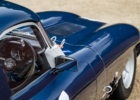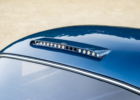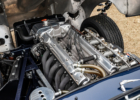1964 Jaguar E-Type Semi-Lightweight Competition
- Jaguar E-type Semi-Lightweight
- Built to 1964 spec with alloy engine (steel engine also available)
- Highly eligible for the world’s greatest historic events
- A front-running car built to the highest standard
| YEAR | 1964 |
| MAKE | Jaguar |
| PRICE | SOLD |
VEHICLE DESCRIPTION
Supplied new to North America as a standard Roadster, this Jaguar E-type has been converted into a competition car of the highest standard and evokes the look and specification of the legendary Lightweight models that were built by the factory in the 1960s.
Race-prepared by renowned Market Drayton-based specialist Valley Motorsport, for Jon Minshaw, the E-type features a highly tuned all-alloy engine that is suitable for events such as Peter Auto’s Sixties Endurance series. The 3.8-litre straight-six is running on triple Weber 48 DCO3 carburettors, plus a six-branch exhaust manifold that runs into a side-exit pipe.
A cast-iron engine that would be suitable for road-based events is also available, and both engines are covered by current HTP papers. The gearbox is the correct 1964-spec Jaguar four-speed manual, driving through a Salisbury Powr-Lok limited-slip diff.
The fire-extinguisher system, seat, harness and fuel cell are all still ‘in date’, while the specification includes a heated windscreen and a high-amp alternator that is ideally suited to endurance racing. This E-type was developed with the Spa Six Hours very much in mind and extra ‘pod-style’ front lights are available.
The suspension, wheel bearings and braking system have all recently been rebuilt. The front suspension is fully adjustable in terms of dampers, geometry and ride height, while anti-roll bars are fitted front and rear. The car is running on Avon tyres – 225/60 at the front and 245/60 at the rear.
Having been built into competition specification, this Jaguar has been raced all over Europe by some of the best-known names on the historic scene. E-type maestro Jon Minshaw raced it in the Graham Hill Trophy at Goodwood’s 74th Members’ Meeting, and later in 2016 he shared it with long-time co-driver Phil Keen in the Gentlemen Drivers race at the Zolder Masters Festival.
After being acquired by enthusiast Martin Halusa, the E-type continued to feature at the sharp end in events such as the Espiritu de Montjuic at Barcelona, the Silverstone Classic and the Spa Six Hours. During this time the specialist team at High Tech Motorsport in Kidderminster have prepared the car to the highest level, irrespective of cost to ensure reliability and competitiveness.
Now being offered for sale with current HTP papers until 2026, this Jaguar E-type Semi-Lightweight has been prepared to exacting standards and is eligible for the greatest events in historic motorsport, from all of those listed above to the Le Mans Classic, Jaguar Classic Challenge and Modena Cento Ore.
MODEL HISTORY
The early 1960s were a golden period for GT racing, with the Ferrari 250 GT Short Wheelbase and GTO going up against the Shelby Cobra, Aston Martin DB4 GT Zagato and Jaguar Lightweight E-type. They were raced by skilled privateers and established aces alike, and between 1962 and 1965 they did battle in the International Championship for GT Manufacturers – the World Sports Car Championship in all but name.
The Jaguar E-type was first raced at Oulton Park in April 1961, with Graham Hill taking his Tommy Sopwith-entered car to victory. The new British challenger offered stern competition to its rivals, which was little wonder considering that the E-type was the ultimate development of a bloodline that started with the XK 120 and continued via the Le Mans-winning D-type.
It used a monocoque centre section with a subframe carrying the engine and front suspension. At the rear, independent suspension was fitted at a time when many of Jaguar’s rivals still employed a traditional live axle, and disc brakes were used all round. Beneath the long bonnet was a triple-carburettor, 265bhp, 3.8-litre straight-six engine.
Through that first season, the E-type won races in the hands of top drivers such as Hill, Roy Salvadori and Michael Parkes, while Ferrari responded to the threat by developing the fabled GTO for 1962. In turn, Jaguar fought back with a short run of 12 Lightweight E-types for the following season. These featured an aluminium monocoque and an engine with an aluminium block rather than the standard cast iron, while developments included fuel injection and, later, a ZF five-speed gearbox.
During 1963 in particular, a Lightweight E-type was more than a match for a Ferrari GTO in British circuit racing – particularly the famous John Coombs car, which was regularly raced by Graham Hill. In 1964, it was also raced by a young Scotsman who was beginning to make a name for himself – Jackie Stewart.
Although it was always first and foremost a road car, the Jaguar E-type had a stellar period competition career and has gone on to be mainstay of the historic-racing scene.
ENQUIRE NOW

Car Storage In The Cotswolds
OXFORDSHIRE • GLOUCESTERSHIRE • COTSWOLDS























































